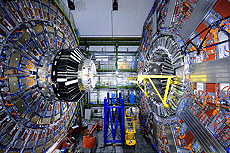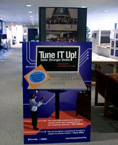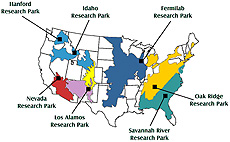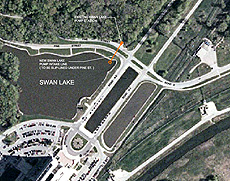|
Have a safe day!
Monday, Nov. 30
2:30 p.m.
Particle Astrophysics Seminar - One West
Speaker: Brian Humensky, University of Chicago
Title: The Galaxy in Gamma Rays: Results from VERITAS
3:30 p.m.
DIRECTOR'S COFFEE BREAK - 2nd Flr X-Over
4 p.m.
All Experimenters' Meeting - Curia II
Tuesday, Dec. 1
10:30 p.m.
Research Techniques Seminar - Curia II
Speaker: Maxim Titov, CEA Saclay
Title: The RD51 Collaboration - Development of Micro-Pattern Gas Detectors Technologies
1 p.m.
Computing Techniques Seminar - FCC2A/2B
Speaker: Steve Tuecke, University of Chicago/Argonne National Laboratory
Title: Globus' Future
3:30 p.m.
DIRECTOR'S COFFEE BREAK - 2nd Flr X-Over
THERE WILL BE NO ACCELERATOR PHYSICS AND TECHNOLOGY SEMINAR TODAY
4 p.m.
Special Fermilab Colloquium - One West
Speaker: Norbert Holtkamp, ITER
Title: ITER - Fusion Energy
Click here for NALCAL,
a weekly calendar with links to additional information.
Upcoming conferences |
|
For information about H1N1, visit Fermilab's flu information site.
|
|
Monday, Nov. 30
- Croissant sandwich
- Potato leek soup
- Monte Cristo
- Half a roasted chicken
- Alfredo tortellini
- Chicken ranch wrapper
- Assorted slices of pizza
- Szechuan style pork lo mein
Wilson Hall Cafe Menu |
|
Wednesday, Dec. 2
Lunch
- Jalapeño and cream cheese
- Stuffed pork tenderloin
- Scalloped potatoes
- Steamed green beans
- Hazelnut torte with cream anglaise
Thursday, Dec. 3
Dinner
- Mushroom duxelle
- Duck breast with lingonberry sauce
- Wild rice
- Brussels sprouts
- German apple cake
Chez Leon Menu
Call x3524 to make your reservation. |
|
|
The Large Hadron Collider sets new world record
CERN just issued a press release announcing that the Large Hadron Collider is now the world's highest energy particle accelerator. Over the weekend the LHC accelerated beams of protons to an energy of 1.18 TeV, breaking the previous world record of 0.98 TeV that had been held by Fermilab since 2001.
Text of CERN press release:
LHC sets new world record
Geneva, 30 November 2009. CERN's Large Hadron Collider has today become the world's highest energy particle accelerator, having accelerated its twin beams of protons to an energy of 1.18 TeV in the early hours of the morning. This exceeds the previous world record of 0.98 TeV, which had been held by the US Fermi National Accelerator Laboratory's Tevatron collider since 2001. It marks another important milestone on the road to first physics at the LHC in 2010.
"We are still coming to terms with just how smoothly the LHC commissioning is going," said CERN Director General Rolf Heuer. "It is fantastic. However, we are continuing to take it step by step, and there is still a lot to do before we start physics in 2010. I'm keeping my champagne on ice until then."
Read more
Read the story by the Associated Press.
|
How to turn on the Compact Muon Solenoid detector
 |
| The 13,800-ton Cosmic Muon Solenoid detector in August 2008 before it was closed by construction crews. |
When two proton bunches traveling in opposite directions at close to the speed of light first met on Nov. 23 within the Compact Muon Solenoid detector at the Large Hadron Collider at CERN, 100 million detection elements were ready to record.
The trickle of collisions recorded so far at CMS will gradually increase to a flood as LHC operators ramp up the collision energy to 7 trillion electron volts. Scientists expect this to generate a data stream of about 100 megabytes per second.
Before detection equipment could record any data from those first collisions, scientists actually had to turn the detector on. Read on to find out how hundreds of scientists and maintenance personnel power up the CMS detector.
First step: perform maintenance
The size and complexity of modern detectors makes it difficult for scientists to find defective or malfunctioning parts until they have thoroughly tested the whole detector. Because of these challenges, detectors often have a breaking-in period with crews performing the most maintenance after the first run. The nine-day operational period in 2008, although brief, gave CMS scientists an adequate glimpse of the detector, allowing them to perform most of the maintenance associated with a first run.
"During the first operational period, things move in the magnetic field and you really have to understand how they move," said Fermilab's Jeff Spalding, project manager for the hadron calorimeter sub-detector. "When you open the detector you have to inspect and look for any sign of movement."
During the initial testing period, maintenance crews located and repaired minor leaks in the cooling system and adjusted some of the mounting to account for the effects of the 3.8 Tesla magnetic field, Spalding said. Crews turned on and tested individual parts of the detector as they performed maintenance so if there were problems, they could find out before reassembling the detector.
Read more
— Chris Knight |
Physical inventory off to a good start
 |
| The Tune IT Up team will post this sign in your office area before they come by for a physical inventory. |
On behalf of the Tune IT Up team, I would like to thank the employees and users who have helped make the launch of the Tune IT Up physical inventory a success. Check out the milestones page on the Tune IT Up site to view our progress.
Contractors from the Kemtah Group IT organization report that Fermilab employees and users consistently have asked to see their Fermilab IDs before allowing them access to their computers. Several employees also have called the Service Desk to verify the identity of contractors, pictured here.
The inventory visits tend to last about 15 minutes per laptop or desktop.
The Tune IT Up team will notify managers and system administrators before visiting each area of the laboratory and will display the sign pictured above the day before they arrive. If you will not be present during the contractors' visit to your area, you can reschedule by opening a Service Desk ticket. We will continue to visit Mac, Linux and Windows machines through the end of the calendar year.
If you have any questions about the inventory, please submit a question to the Tune IT Up team or call the Service Desk at x2345.
Thanks again for your cooperation and for helping to make this a safe, efficient process that will improve cybersecurity across the laboratory.
— Mark Kaletka, Tune IT Up
|
Energy push spurs shift
in U.S. science
From The Wall Street Journal, Nov. 25, 2009
The Obama administration's push to solve the nation's energy problems, a massive federal program that rivals the Manhattan Project, is spurring a once-in-a-generation shift in U.S. science.
The government's multibillion-dollar push into energy research is reinvigorating 17 giant U.S.-funded research facilities, from the Oak Ridge National Laboratory here to the Lawrence Berkeley National Laboratory in California. After many years of flat budgets, these labs are ramping up to develop new electricity sources, trying to build more-efficient cars and addressing climate change.
Read more |
|
|
Fermilab's land is a vital national research location
 |
| Fermilab is one of seven Department of Energy National Environmental Research Parks. |
We all know that Fermilab is a premier high-energy physics laboratory. But did you realize that Fermilab is also one of only seven Department of Energy National Environmental Research Parks in the United States? These parks, or NERPs, began in the early 1970s at outdoor laboratories where research on major U.S. ecosystems could be carried out at a large scale. The first NERP was dedicated at the Savannah River Site in South Carolina in 1972.
The study of natural systems' response to human activities is fundamental to the NERP concept. DOE laboratories offer a unique opportunity to take a close look at both the response and the activities that trigger the natural response.
The Fermilab NERP was created in 1989 to enable the study of the tall grass prairie ecosystem. Since then, the Fermilab NERP has hosted more than 80 research projects from 24 universities, seven non-governmental research institutions (e.g., The Field Museum, Morton Arboretum) and federal and local agencies. Argonne National Laboratory has been a major contributor to this research for three decades. Investigators have studied the biogeochemistry of prairie soils, soil nutrient cycling, atmospheric carbon dynamics and, most recently, uses for prairie grasses as alternative fuel sources.
Recently, a bill was introduced in Congress to give legislative status to the NERP network members and to authorize annual funding for each of the NERP sites. Coordinators from all the DOE NERPs met last week at Savannah River to discuss the future of research if the funding materializes. All of the NERPs are conducting interesting and important environmental research, and the workshop participants concentrated on exploring the potential for future projects that involve coordinating our efforts to study continental-scale issues like climate change and alternative energy.
Learn more about the DOE NERP program at its Web site.
Each NERP is located in a distinct and important large ecosystem. Fermilab's NERP represents the tall grass prairie.
— Rod Walton, Fermilab ecologist |
Work begins near Pine Street and Road A this week
 |
| Construction crews will partially drain Swan Lake to replace an intake pipe near the corner of Pine Street and Road A. Construction will require periodic traffic controls at the intersection. |
Starting this week, construction crews will begin preparations to replace the intake pipe at the Swan Lake pumping station on the corner of Pine Street and Road A.
In order to replace the pipe, which runs under Pine Street and into Swan Lake, crews will lower the water level in the lake significantly. FESS personnel do not expect the lower water level to affect the fish in the lake, although the number of great egrets fishing may increase.
Current construction plans do not call for any road closures, but periodic traffic control will occur at the intersection. All drivers and bicyclists should take extra caution and be aware of workers when entering the intersection.
FESS plans to complete the project in December. Normal landscape restoration will take place in the spring.
|
|